მიქელანჯელო (Michelangelo)
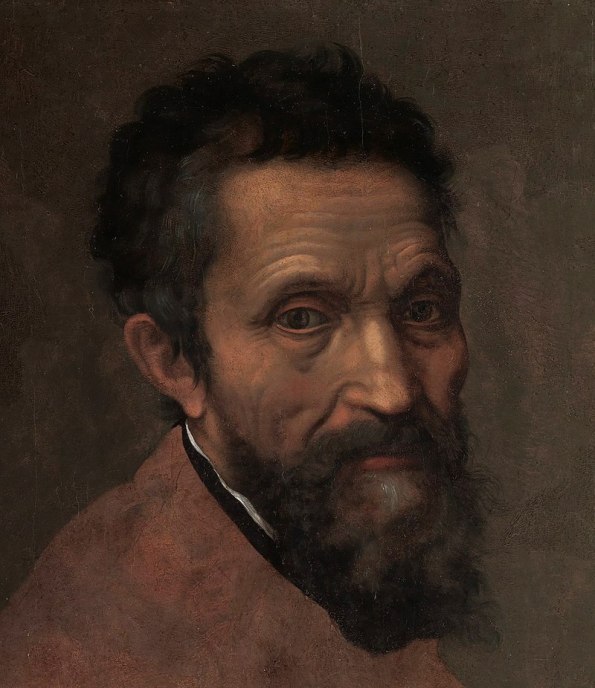
Portrait of Michelangelo by Daniele da Volterra

The Statue of David, completed by Michelangelo in 1504, is one of the most renowned works of the Renaissance.
მიქელანჯელო დი ლოდოვიკო ბუონაროტი სიმონი (6 მარტი, 1475 – 18 თებერვალი, 1564), ცნობილი როგორც მიქელანჯელო — იტალიური რენესანსის პერიოდის მოქანდაკე, მხატვარი, არქიტექტორი და პოეტი. მიუხედავად იმისა, რომ ხელოვნების გარეთ სხვა დარგებს თითქმის არ შეხებია, ის უზადობა, რომელიც მის შემოქმედებას ახასიათებს ყველა დისციპლინაში, რომელშიც კი ოდესმე შეუქმნია, მას რენესანსის არქეტიპი ადამიანის ტიტულს ანიჭებს, მის მოპაექრე და თანამოქალაქე ფლორენციელ ლეონარდო და ვინჩისთან ერთად. მიქელანჯელო დაიბადა ლუდოვიკო ლეონარდო ბუონაროტის ოჯახში 1475 წლის 6 მარტს ქალაქ კაპრეზში (ახლანდელი პროვინცია არეცო), ფლორენციის მახლობლად. დედამისი იყო ფრანჩესკა დე ნერი დი მინიატო დელ სერა. მას ხუთი შვილი ჰყავდა და გარდაიცვალა, როცა მიქელანჯელო მხოლოდ ექვსი წლისა იყო.
მამამისი ადგილობრივი თვითმმართველობის თავი იყო. ის სასტიკი წინააღმდეგი იყო იმისა, რომ საკუთარი შვილი მოქანდაკე ყოფილიყო და მის მომავალთან დაკავშირებით სხვა გეგმები ჰქონდა. ამან განაპირობა მიქელანჯელოს გადაწყვეტილება, 13 წლის ასაკში, გადასულიყო დომენიკო გირლანდაიოს სახელოსნოში, მის ასისტენტად. სადაც ის, სამი წლის განმავლობაში, ფრესკის ხელობას ეუფლებოდა და ცნობილი მხატვრების ნამუშევრების ხატვას ცდილობდა, რასაც ისე ახერხებდა, რომ ხშირად ორიგინალისაგან გარჩევა შეუძლებელი იყო. სწორედ გირლანდაიოს რეკომენდაციით სწავლობდა და მუშაობდა მიქელანჯელო, 1490−1492 წლებში, ფლორენციის იმდროინდელ მმრათველ, ლორენცო მედიჩის ვილაში. ამ პერიოდის ნამუშევრებია, „კენტავრების ბრძოლა“ და „მადონა კიბესთან”. როცა 1492 წელს მეგობარმა პოეტმა ანჯელო პოლიციანომ შეაგულიანა ბარელიეფის პირველი ესკიზი გაეკეთებინა, ოვიდიუსის „მეტამორფოზების“ XII წიგნით შთაგონებულმა მიქელანჯელომ მარმარილოში გამოკვეთა „კენტავრების ბრძოლა“. ნაწარმოების შექმნიდან სულ ცოტა ხანში მიქელანჯელომ გამოკვეთა „მადონა კიბეზე“, რომელშიც დონატელოსა და ტრადიციული წმინდა ხელოვნების სტილისტური ხერხები გამოიყენა. ლორენცოს გარდაცვალების შემდეგ, ფლორენციის ახალმა მმართველმა, პიერო მედიჩიმ უარი თქვა მიქელანჯელოს ვილაში დარჩენაზე. 1492 წელს გადავიდა ახალგაზრდა ხელოვანი ბოლონიაში. ბოლონიაში მიქელანჯელომ სან-დომენიკო მაჯორეს ეკლესიისთვის გამოკვეთა „მუხლმოყრილი ანგელოზი“, ანტიკური სულის ნამუშევარი. 20 წლის მიქელანჯელო მიიღო ალდოვრანდის ოჯახის ერთ-ერთმა წევრმა, რომლის

The Madonna of the Stairs (1490–92), Michelangelo’s earliest known work in marble
დავალებითაც მან წმინდა პეტრონიუსის ეკლესიაში, წმინდა დომინიკუსის სამარხისათვის, ორი წმინდანის ფიგურა და ერთი ანგელოზის ქანდაკება შექმნა. ერთი წლის შემდეგ, როცა მისმა ხელოვნებამ ბოლონიაში დიდ წარმატებას ვერ მიაღწია, მიქელანჯელო სავონაროლაში დაბრუნდა.
მიქელანჯელო რომში 1496 წლის 25 ივნისს 21 წლის ასაკში ჩავიდა. იმავე წლის 4 ივლისს, კარდინალ რაფაელ რიარიოს დავალებით მან მუშაობა ბახუსის ქანდაკებაზე დაიწყო, თუმცა კარდინალს მისი ნამუშევარი არ მოეწონა და ქანდაკებამ ადგილი ბანკირი ჯაკოპო გალის ბაღში დაიდო. რომში კარდინალმა ბილჰერეს დე ლაგრაულასმა, სან-დიონისოს აბატმა და საფრანგეთის მეფე კარლოს VIII-ს ელჩმა პაპ ალექსანდრე VI-ს კარზე, მიქელანჯელოს ქანდაკება შეუკვეთა. 1499 წელს მიქელანჯელომ დაასრულა „პიეტა“. 1501 წელს ფლორენციაში დაბრუნებულმა სენიორიის მოედნისთვის ზომების გამო „გიგანტად“ წოდებული „დავითის“ გამოკვეთა დაიწყო. ცოტა ხნის შემდეგ ტემპერით ხეზე დახატა „ტონდო დონი“, რომელიც წარმოგვიდგენს წმინდა ოჯახსა და წმინდა იოანე ნათლისმცემელს. პაპმა იულიუს II-მ, რომელმაც თავისი პაპობა ეკლესიის დამოუკიდებლობის განმტკიცებასა და იტალიაში საეპისკოპოსო სახელმწიფოს საზღვრების გაფართოებას შეალია, მიქელანჯელო ვატიკანის ბაზილიკაში დიდებული აკლდამის შესაქმნელად დაიბარა.
იულიუს II-ს მიქელანჯელოს 40-ქანდაკებიანი პროექტი ისე მოეწონა, რომ იგი მაშინვე გაგზავნა კარარის სამტეხლოში. რვა თვის განმავლობაში ხელოვანი არჩევდა და ჭრიდა მარმარილოს ლოდებს. თუმცა პაპის ეს გატაცება დიდხანს არ გაგრძელებულა. როგორც ჩანს, პაპის არქიტექტორმა დონატო ბრამანტემ და მისმა მეგობარმა რაფაელმა იულიუს II დაარწმუნეს, რომ არ ღირდა აკლდამა სიცოცხლეშივე აეგო და უზარმაზარი ბაზილიკის პროექტი წარუდგინეს, რომელიც ქრისტეს ეკლესიის ძლევამოსილებისა და დიდების მსოფლიო სიმბოლო იქნებოდა. მართლაც, რომის პაპმა თვის სახელის უკვდავსაყოფად არა აკლდამის აშენება, არამედ მონუმენტური ტაძრის რეკონსტრუქცია გადაწყვიტა. მიქელანჯელო სამუშაოს გასაგრძელებლად საჭირო თანხისა და მხარდაჭერის გარეშე დარჩა.
იულიუს II-მ, რომელმაც 1506 წელს ბოლონია დაიკავა, ბრინჯაოს ქანდაკება შეუკვეთა. რამდენიმე წლის შემდეგ ქანდაკება გაანადგურეს. თითქმის იმავდროულად იულიუს II-მ მიქელანჯელოს შესთავაზა მოეხატა სიქსტეს კაპელის თაღი, რომელიც ადრექრისტიანული ტაძრების დარად ცისფრად შეღებილი და ოქროსფერი ვარსკვლავებით მოჭედილი იყო. მიქელანჯელო ჯერ უარზე იდგა, რადგან მხატვრობა ქანდაკებასთან შედარებით წვრილმან საქმედ მიაჩნდა. 1508–1512 წლებში მიქელანჯელო რამდენიმე ესკიზითა და რამდენიმე ფლორენციელი მუშის დახმარებით შრომას შეუდგა. მალე მუშების უმრავლესობა დაითხოვა და სიქსტეს კაპელაში გამოიკეტა და შიგ არავის უშვებდა და მარტო მუშაობდა.

Pietà, St Peter’s Basilica (1498–99)
მიქელანჯელომ 1524 და 1531 წლებში შექმნა „ჰერცოგების აკლდამები“, მაგრამ პროექტი არ დასრულებულა. რომში მიქელანჯელო სანტა-მარია-დი-ლორეტოს ეკლესიის მახლობლად ცხოვრობდა. მიქელანჯელოს სახლი 1874 წელს დაანგრიეს, ხოლო შემორჩენილი არქიტექტურული ელემენტები 1930 წელს განადგურდა. მისი სახლის რეკონსტრუქცია დღისთვის იანიკულის ბორცვზე მდებარეობს.
1546 წელს მიქელანჯელო ვატიკანში დაინიშნა წმინდა პეტრეს ბაზილიკის არქიტექტორად. 1542 წელს პავლეს კაპელისთვის მუშაობა დაიწყო „სავლეს მოქცევაზე“, რასაც მოჰყვა „წმინდა პეტრეს ჯვარცმა“, რომელიც 1550 წელს დაასრულა. წმინდა პეტრეს ბაზილიკის დასრულებამდე, 1564 წელს მიქელანჯელო 88 წლის ასაკში გარდაიცვალა. მისი სურვილის მიხედვით ის რომიდან ფლორენციაში გადაასვენეს და დაკრძალეს სანტა კროჩეს ბაზილიკაში.

Michelangelo painted the ceiling of the Sistine Chapel; the work took approximately four years to complete (1508–12)
Michelangelo di Lodovico Buonarroti Simoni (6 March 1475 – 18 February 1564), known best as simply Michelangelo, was an Italian sculptor, painter, architect and poet of the High Renaissance born in the Republic of Florence, who exerted an unparalleled influence on the development of Western art. Considered by many the greatest artist of his lifetime, and by some the greatest artist of all time, his artistic versatility was of such a high order that he is often considered a contender for the title of the archetypal Renaissance man, along with his rival, the fellow Florentine and client of the Medici, Leonardo da Vinci.
A number of Michelangelo’s works of painting, sculpture and architecture rank among the most famous in existence. His output in these fields was prodigious; given the sheer volume of surviving correspondence, sketches and reminiscences, he is the best-documented artist of the 16th century. He sculpted two of his best-known works, the Pietà and David, before the age of thirty. Despite holding a low opinion of painting, he also created two of the most influential frescoes in the history of Western art: the scenes from Genesis on the ceiling of the Sistine Chapel in Rome, and The Last Judgment on its altar wall. His design of the Laurentian Library pioneered Mannerist architecture. At the age of 74, he succeeded Antonio da Sangallo the Younger as the architect of St. Peter’s Basilica. He transformed the plan so that the western end was finished to his design, as was the dome, with some modification, after his death.
Michelangelo was the first Western artist whose biography was published while he was alive. In fact, two biographies were published during his lifetime. One of them, by Giorgio Vasari, proposed that Michelangelo’s work transcended that of any artist living or dead, and was “supreme in not one art alone but in all three”.
In his lifetime, Michelangelo was often called Il Divino (“the divine one”). His contemporaries often admired his terribilità—his ability to instil a sense of awe. Attempts by subsequent artists to imitate Michelangelo’s impassioned, highly personal style resulted in Mannerism, the next major movement in Western art after the High Renaissance.
source: https://en.wikipedia.org/wiki/Michelangelo
Michelangelo Quotes:
“A beautiful thing never gives so much pain as does failing to hear and see it.”
“A man paints with his brains and not with his hands.”
“Carving is easy, you just go down to the skin and stop.”
“Death and love are the two wings that bear the good man to heaven.”
“Even if you are divine, you don’t disdain male consorts.”
“Every beauty which is seen here by persons of perception resembles more than anything else that celestial source from which we all are come.”
“Every block of stone has a statue inside it and it is the task of the sculptor to discover it.”
“Faith in oneself is the best and safest course.”
“From such a gentle thing, from such a fountain of all delight, my every pain is born.”
“Genius is eternal patience.”
“Good painting is the kind that looks like sculpture.”
“I am a poor man and of little worth, who is laboring in that art that God has given me in order to extend my life as long as possible.”
“I am still learning.”
“I cannot live under pressures from patrons, let alone paint.”

Signature
“I have never felt salvation in nature. I love cities above all.”
“I hope that I may always desire more than I can accomplish.”
“I live and love in God’s peculiar light.”
“I live in sin, to kill myself I live; no longer my life my own, but sin’s; my good is given to me by heaven, my evil by myself, by my free will, of which I am deprived.”
“I saw the angel in the marble and carved until I set him free.”
“If in my youth I had realized that the sustaining splendour of beauty of with which I was in love would one day flood back into my heart, there to ignite a flame that would torture me without end, how gladly would I have put out the light in my eyes.”
” If people knew how hard I worked to get my mastery, it wouldn’t seem so wonderful at all.”
“If we have been pleased with life, we should not be displeased with death, since it comes from the hand of the same master.”
“It is necessary to keep one’s compass in one’s eyes and not in the hand, for the hands execute, but the eye judges.”
“It is well with me only when I have a chisel in my hand.”

The Last Judgement (1534–1541)
“Lord, grant that I may always desire more than I can accomplish.”
“Many believe – and I believe – that I have been designated for this work by God. In spite of my old age, I do not want to give it up; I work out of love for God and I put all my hope in Him.”
“My soul can find no staircase to Heaven unless it be through Earth’s loveliness.”
“The best artist has that thought alone Which is contained within the marble shell; The sculptor’s hand can only break the spell To free the figures slumbering in the stone.”
“The best of artists has no conception that the marble alone does not contain within itself.”
“The greater danger for most of us lies not in setting our aim too high and falling short; but in setting our aim too low, and achieving our mark.”
“The greatest artist has no conception which a single block of white marble does not potentially contain within its mass, but only a hand obedient to the mind can penetrate to this image.”
“The marble not yet carved can hold the form of every thought the greatest artist has.”
“The more the marbles wastes, the more the statue grows.”
“The promises of this world are, for the most part, vain phantoms; and to confide in one’s self, and become something of worth and value is the best and safest course.”
“The true work of art is but a shadow of the divine perfection.”
“There is no greater harm than that of time wasted.”
“Trifles make perfection, and perfection is no trifle.”
“What do you despise? By this you are truly known.”
“What spirit is so empty and blind, that it cannot recognize the fact that the foot is more noble than the shoe, and skin more beautiful than the garment with which it is clothed?”
Paintings:
10. მიქელანჯელო (Michelangelo)
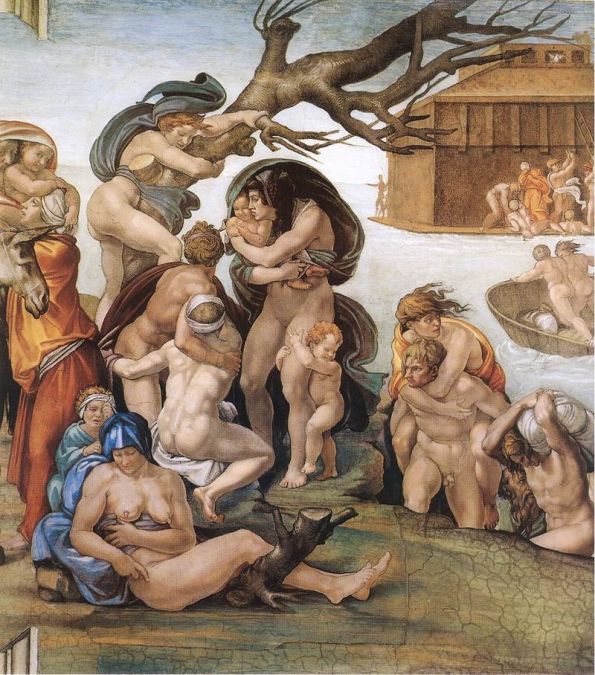
The Deluge (detail)
09. მიქელანჯელო (Michelangelo)
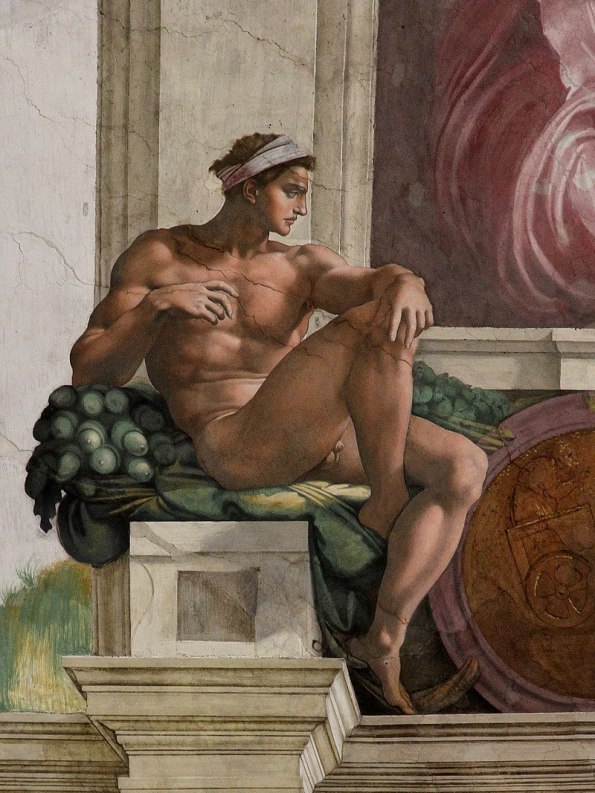
Ignudo
08. მიქელანჯელო (Michelangelo)
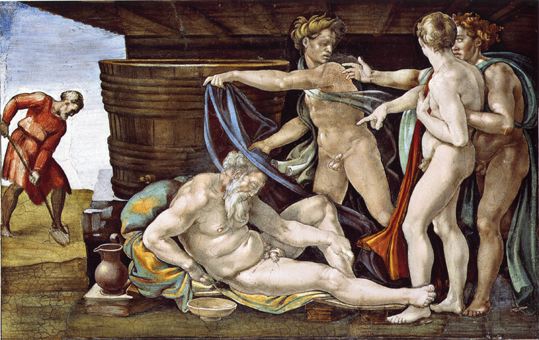
The Drunkenness of Noah
07. მიქელანჯელო (Michelangelo)
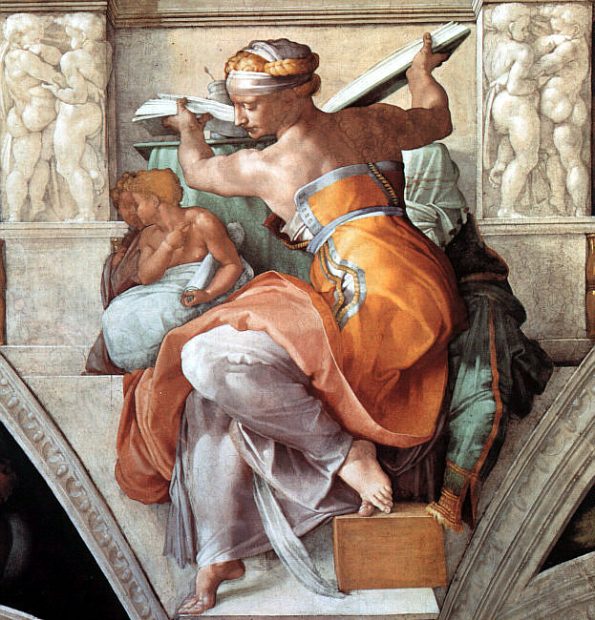
The Libyan Sibyl (1511)
06. მიქელანჯელო (Michelangelo)
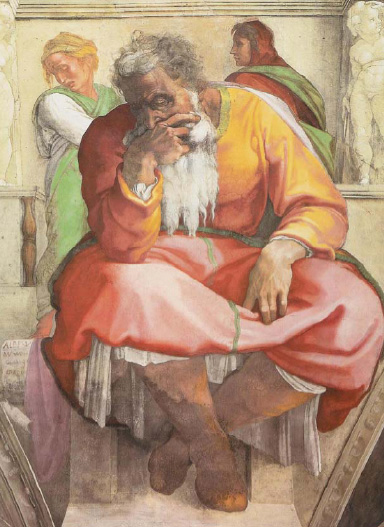
The Prophet Jeremiah (1511)
05. მიქელანჯელო (Michelangelo)
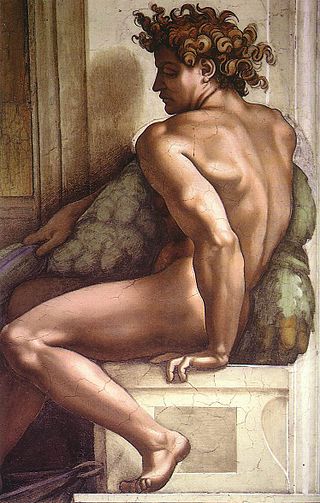
Ignudo fresco from 1509 on the Sistine Chapel ceiling
04. მიქელანჯელო (Michelangelo)
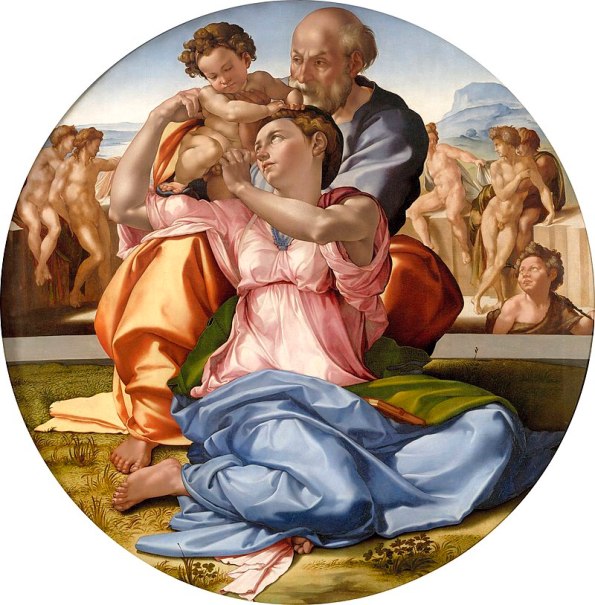
The Doni Tondo (1504–06)
03. მიქელანჯელო (Michelangelo)
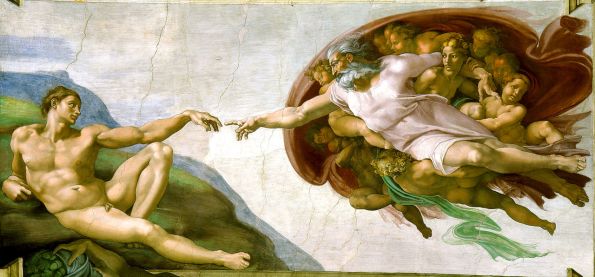
The Creation of Adam (1510)
02. მიქელანჯელო (Michelangelo)
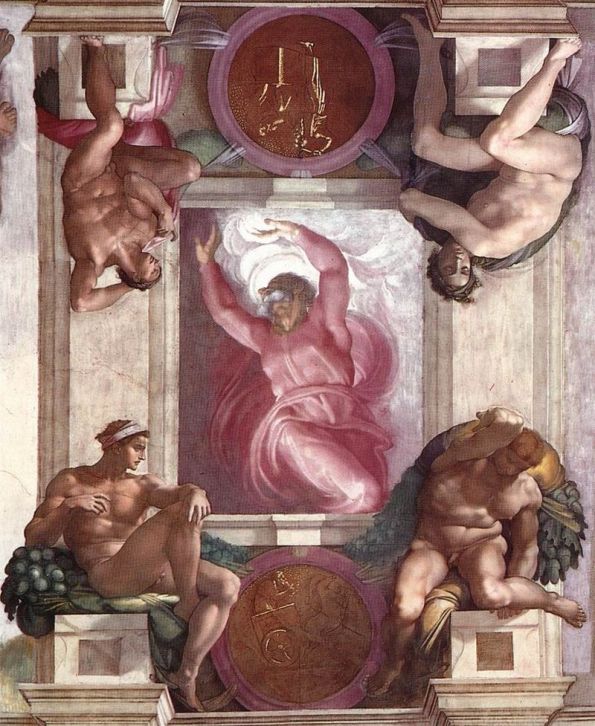
The First day of Creation
01. მიქელანჯელო (Michelangelo)
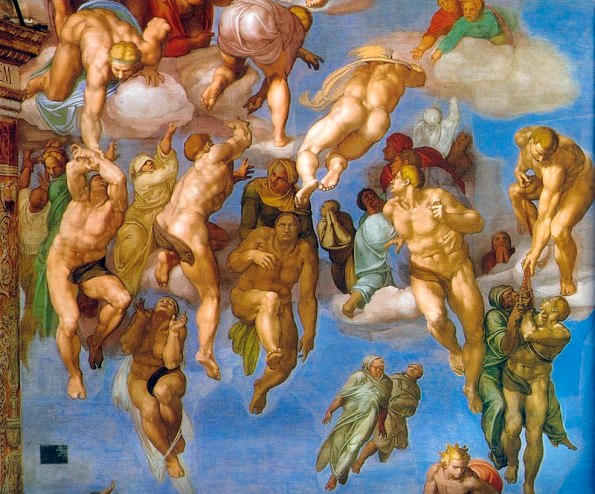
The Last Judgment, detail of the Redeemed.





იმდენად სრულყოფილი და მეტყველია მისი ქმნილებები რომ როდესაც ვუყურებ, მგონია სადაცაა გაცოცხლდება და დაილაპარაკებს. ))
LikeLike